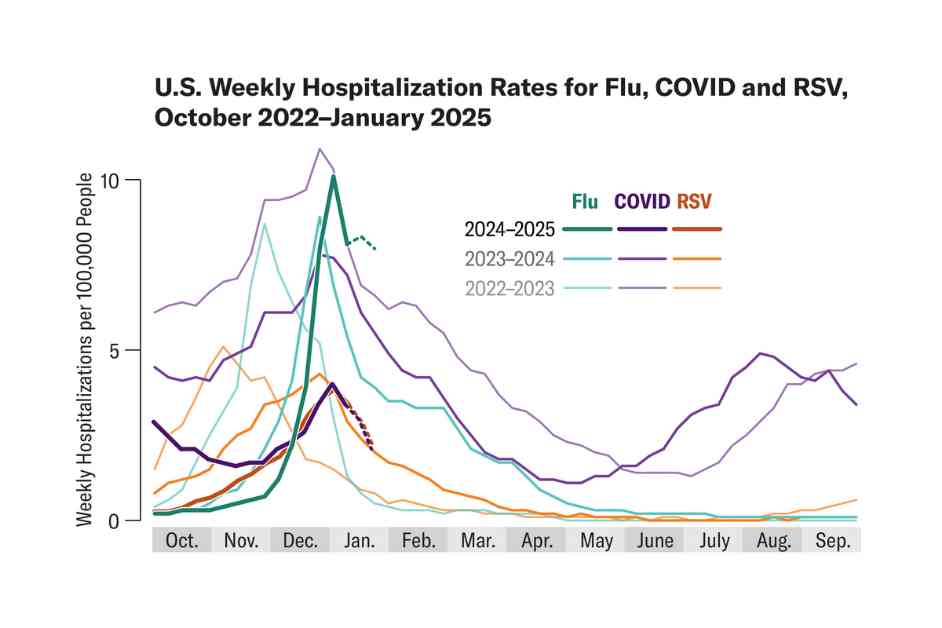The winter of 2021 has brought a flurry of respiratory illnesses, from the flu to COVID and RSV. As the Northern Hemisphere’s typical respiratory illness season hits its stride from October to May, hospitals are grappling with high levels of sickness. While flu hospitalizations have decreased from an early peak in January, they still remain elevated, with the possibility of a rebound. Wastewater samples indicate declining levels of COVID, but the virus is still prevalent. Meanwhile, RSV is sending people to hospitals, although not at the same levels as flu or COVID. Despite the widespread sniffles, this year seems to be following a fairly standard trajectory for respiratory viruses.
Flu Season Insights
The current flu season mirrors past years, with the exception of the 2020–2021 season when flu virtually disappeared due to COVID-related precautions. Weekly hospitalization rates peaked around January 4 and have since shown a slight decline, though reporting delays may obscure the full picture. Recent data suggest a potential uptick in infections, possibly due to decreased vaccine effectiveness. While reports of a less effective flu vaccine may explain the current high sickness rates, this season does not appear to be unusually severe.
Epidemiologist Jennifer Nuzzo from Brown University notes that this year’s flu season started late but is still ongoing, offering uncertainty about its trajectory. To protect against severe illness, health officials advise getting the flu vaccine, especially for older individuals and those with underlying health conditions. Additional preventive measures include masking, avoiding crowds, and staying in well-ventilated spaces. Antiviral medications like Tamiflu can be prescribed for positive flu cases.
COVID Considerations
COVID hospitalizations have seen a smaller spike this winter compared to previous seasons, likely due to widespread immunity from vaccination or prior infections. SARS-CoV-2, the virus responsible for COVID, has not undergone significant recent mutations. The increased vaccination rate among individuals over 65 may have contributed to the lower hospitalization numbers. While COVID does not exhibit a clear seasonal pattern like flu and RSV, it often peaks at least twice a year, suggesting a strong behavioral component to transmission.
Katelyn Jetelina, an epidemiologist, emphasizes the importance of staying up-to-date on COVID vaccines, particularly for high-risk groups. For individuals at elevated risk of severe disease, the antiviral medication Paxlovid is recommended within the first five days of symptom onset. While COVID claims more lives annually than the flu, this winter has seen double the number of flu hospitalizations compared to COVID cases.
RSV Trends
RSV is experiencing a typical year, with hospitalizations peaking and declining. This milder season may be attributed to the virus reverting to its regular patterns. The approval of RSV vaccines for older adults and pregnant individuals has likely bolstered protection levels. Furthermore, a prophylactic antibody drug is available for young children and newborns to guard against RSV.
Other Respiratory Viruses
In addition to the flu, COVID, and RSV, other viruses are circulating this season. Norovirus outbreaks have surged, likely due to a mutated strain that evades population immunity. Human metapneumovirus cases have also been reported, but experts do not view it as a significant threat. Various common cold viruses, including rhinoviruses and adenoviruses, are making the rounds, causing discomfort but generally not requiring hospitalization.
Staying Home and Hygienic Practices
Overall, it’s advisable to stay home when feeling unwell, if possible. Limiting contact with others and consistent handwashing with soap and water are crucial preventive measures, particularly for norovirus transmission. While respiratory viruses continue to circulate, maintaining good hygiene practices and following public health guidelines can help reduce the spread of illness.
As we navigate the complexities of the winter season with multiple respiratory viruses in play, a combination of vaccination, preventive measures, and prudent healthcare decisions can help us stay healthy and resilient in the face of these challenges.










